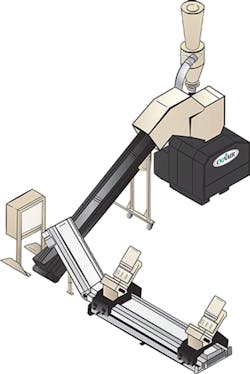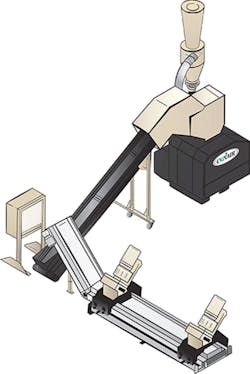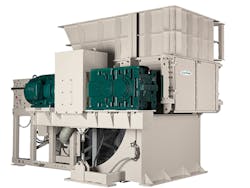Recycling: Conair reclaim system designed for thick sheet
If you say the word "recycling," the average citizen will immediately think of separating the plastic, glass and paper packaging that goes into the recycling bin. Say the words "scrap-reclaim" and the citizen pretty much draws a blank. Meanwhile, any plastics processors in the room will be paying close attention, for several good reasons.
First, even an efficient, well-controlled plastics production system produces scrap. Second, depending on the process, the scrap can add up to many hundreds of pounds per shift. Third, even the lower-cost commodity resins that were 30 to 50 cents per pound a decade ago cost a dollar or more today. Fourth, all scrap material reclaimed and made into finished product is a serious bottom line booster.
"One thing sheet extruders are increasingly preoccupied with is scrap reclaim. Whether they do it for economic reasons or environmental reasons or both, sheet extruders are reusing more scrap in their products than ever before." That's Gene Flockerzi, VP of sales-packaging for auxiliary equipment producer Conair, Cranberry Township, Pa., answering a PMM inquiry about the integrated, in-line scrap-reclaim system Conair designed specifically for extruders of thick plastic sheet.
How to reclaim thick sheet edge trim
The Conair in-line scrap-reclaim system automatically reclaims edge trim from extruded sheet that's 0.15-inch thick or thicker and regrinds it for blending with virgin material. The edge trim of a thick-sheet line with a throughput of 2,000 or 3,000 pounds per hour is a cost savings that's anything but trivial.
Vincent Carpentieri, Conair's size-reduction sales manager, notes that trim from sheet thinner than 0.15 inch can be handled by a conventional granulator with a roll feeder to pull the edge strips into the cutting chamber.
"Trim from sheet over 0.15 inch, however, is not flexible, and needs to be cut into smaller sections before feeding it to a granulator," he says.
Accordingly, Conair's solution begins with two guillotine cutters placed in line with the edge trim to cut the continuous strips into 3- to 6-inch pieces that drop onto a conveyor running underneath the sheet. They are carried to a second conveyor that feeds them into a conventional granulator for size reduction. The resulting regrind is evacuated from the granulator catch bin and conveyed to a cyclone receiver that separates regrind from conveying air. If the application generates high levels of dust or fines, an elutriator can be used to separate the dust and fines from the conveying air. The regrind then drops into a surge bin or other storage container from which it's conveyed to the extruder, usually by a vacuum system.
Creating "process-neutral" regrind that blends well
Flockerzi says a reclaim system starts with the size-reduction solution — granulators or single-shaft shredders — to ensure the required quality and uniformity of the regrind, regardless of the form or forms of the scrap.
"What we try to achieve is what we call 'process-neutral' regrind," he explains. "We configure our equipment so that the regrind can fit seamlessly into the process, so that it is as similar to virgin resin as possible.
"The key to making effective use of granulated scrap is uniformity. Regrind that is consistent in size and shape, with minimal fines and dust, will be easier to handle, melt more evenly and contribute to a more stable process.
"The granulator cutting chamber and rotor should be spec'd for the type of scrap it will be processing," says Carpentieri. Thicker scrap, such as edge trim from sheet thicker than 0.15 inch can be handled with a straight-drop cutting chamber. Usually, a double-scissors cut, where the rotating knives meet the stationary bed knives at an angle, is preferred to ensure that they slice through the scrap cleanly instead of smashing it into pieces. An open rotor allows air circulation that helps keep temperatures down to prevent agglomeration. Properly sized screen holes — generally smaller to increase bulk density of thin-sheet regrind and larger to increase throughput of thicker sheet — minimize fines and dust and reduce energy requirements.
In some cases, says Flockerzi, the regrind can be fed directly into the extruder feed throat via a ratio valve. When more accurate mixing of virgin and regrind is required, a gravimetric blender from Conair's TrueBlend series, which uses a feed-forward learning algorithm for greater accuracy in critical blend applications, can be used.
Reclaim possible with all extrusion, thermoforming scrap
Carpentieri points out that sheet extrusion scrap is found in many forms besides thick sheet, and that each has its own feeding issues for reclaim, but, "Each of them can be met with the right equipment."
As mentioned above, edge trim from extruded sheet thinner than 0.15 inch can be handled in a conventional granulator with a roll feeder pulling the strips into the cutting chamber.
Here are some other solutions:
Off-spec rolls of thinner sheet, perhaps from startup, and rolled thermoforming skeletons can be fed directly to a granulator. Rolls are usually mounted on a stand and the sheet is fed through a pair of grooved counter-rotating rollers that pull the material into the cutting chamber of the granulator. A dancer bar or similar device may be used to ensure that film is drawn smoothly through the rollers and into the granulator.
A similar roller arrangement may be used to draw thicker-sheet scrap, such as thermoforming skeletons or scrap sheet with formed containers still intact, into the granulator. To collapse oversized sheets so they fit through the feed section of the granulator, a set of rolls called a "deformer" may be used. When skeletons are being ground in-line with the extruder and thermoformer, a dancer or other tensioning device will control the rollers so they synchronize with other process equipment to avoid web breaks and jams.
When the scrap is big it may need to be cut down for feeding into a granulator. A processor can automate that usually time- and people-intensive manual operation by using a shredder. Bulk scrap is dumped into its oversized hopper, which reduces it to small chunks that are easily conveyed to a granulator.
Rob Neilley, senior correspondent


